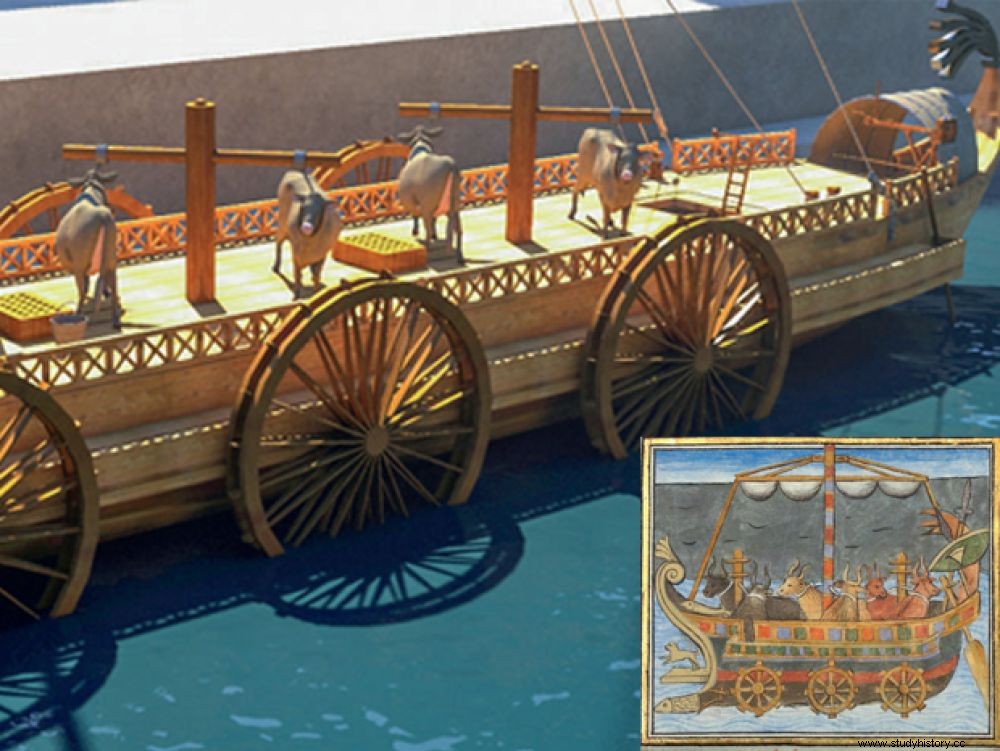Researchers have reconstructed in 3D the terrifying weapons of war of the Romans of the 4th century. An excerpt from the article to read in the March 2018 issue of Sciences et Avenir (number 853).

The ox liburnum (copy from the 15th century after the antique drawing) is one of the innovative devices on offer. The paddle steamer is propelled by cattle (above, 3D reconstruction).
This text is an excerpt from Bernadette Arnaud's article "Innovation, the spearhead of the Roman legions", the full text of which can be read in Sciences et Avenir 853, on newsstands until March 21, 2018. This issue is on the cover of "The Magic Numbers That Make the Universe".
At the end of IV e century, the Roman borders were besieged on all sides. Emperor Valentinian I st tries by all means to contain the barbarian peoples who crowd there. The legions are struggling to repel them despite the most modern weapons of the time. And the very expensive maintenance of these 400,000 men, their horses and their equipment literally strains the imperial budget. A man then tries to distill advice to the emperor:improvement of existing equipment, optimization of expenses and, above all, development of new offensive equipment... "It's a first! No one had ever before, in antiquity, embraced all these problems from the economic, fiscal, monetary and technical point of view at the same time ", enthuses Philippe Fleury, historian, director of Cireve (Interdisciplinary Center for Virtual Reality) at the University of Caen-Normandy, who has just translated into French the few pages on yellowed vellum by an anonymous author who have come down to us and on which these recommendations are noted*. A job that took him twenty years.
"De rebus bellicis (On Military Affairs) is an exceptional manuscript of which there is no equivalent in the history of literature, he explains. If the original work has been lost, there are copies of the XV th century of these texts written in the 4 th century of our era, then inserted in a compilation probably made between the time of Charlemagne (VIII th -IX e century) and the XI th century. “Documents unearthed from a collection of manuscripts kept in the cathedral of Speyer (Germany) and which, extremely rare, also include copies of the original illustrations. 3D by combining written information and polychrome reproductions.
The legions, the main item of state expenditure
"The legions are in the Roman Empire the main item of state expenditure, recalls Yann Le Bohec, professor emeritus at the University of Paris-Sorbonne, specialist in the Roman army. The maintenance of horses and men, the manufacture of armor and weapons required a budget reaching 50% to 80% of income". An army which is however already no longer organized in strong legions of 5000 men as at its peak. "They disappeared, replaced by units of 1000 men divided into auxiliary troops, cohorts, wings, numerii, continues Yann Le Boec. Detachments, called vexillations, are installed more or less permanently in the empire".
A large part of the work concerns the clever optimization of various equipment and war machines such as ballistae, these powerful arrow throwers of which there are two types:the field ballista, light, mounted on four wheels, called ballista quadrirotis , and that of rampart that the author calls ballista fulminalis , the "lightning ballista". Appeared among the Greeks under Alexander the Great from the 4th th century before our era, this machine constituted a revolution in the art of war. "Already, Athenaeum the Mechanic (I st century BC) said that they threw lines up to three and a half stadia (620 meters) when the Roman historian Flavius Josephus (37-100) affirms that those of the Emperor Titus in front of Jerusalem carry two furlongs (355 meters)" , specifies Philippe Fleury.
What the author proposes is to replace the complex wiring system used to tension the machine with a series of gears. And to improve the design of the drawer on which the projectiles are placed, to better adjust the shot. In particular, he suggests a horizontal pointing system, involving a 360° rotating platform, as well as a vertical axis with cogwheel and worm gears.
